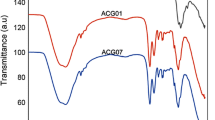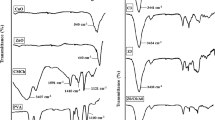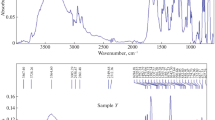Abstract
With the purpose of examining cross-linking agents, we used glutaraldehyde and ammonium persulfate to synthesize nanohydrogels based on poly(vinyl alcohol), chitosan, and magnetite nanoparticles. Fe3O4 nanoparticles were produced by coprecipitation in alkaline solution under sonication followed by coating with chitosan. Then, poly(vinyl alcohol) was combined with chitosan in the presence of glutaraldehyde and ammonium persulfate as cross-linking agents. The Fe3O4 nanoparticles had nanoscale size that was confirmed by XRD, SEM, and TEM. VSM measurements showed that all samples were superparamagnetic. Physicochemical properties of nanohydrogels were measured by DLS and zeta potential. The unspecific adsorption and interaction of nanohydrogels with bovine serum albumin and immunoglobulin G were investigated systematically by UV-Vis spectroscopy method. The release profile of nanohydrogels showed that nanohydrogels cross-linked with glutaraldehyde represent more sensitivity to pH. These nanohydrogels had more and faster release in acidic release medium.










Similar content being viewed by others
References
Fu, Y., & Kao, W. J. (2010). Drug release kinetics and transport mechanisms of non-degradable and degradable polymeric delivery systems. Expert Opinion on Drug Delivery, 7(4), 429–444.
Blanco, E., Shen, H., & Ferrari, M. (2015). Principles of nanoparticle design for overcoming biological barriers to drug delivery. Nature Biotechnology, 33, 941.
Kai, M. P., et al. (2015). Evaluation of drug loading, pharmacokinetic behavior, and toxicity of a cisplatin-containing hydrogel nanoparticle. Journal of Controlled Release, 204, 70–77.
Vall, M., et al. (2017). Effects of amine modification of mesoporous magnesium carbonate on controlled drug release. International Journal of Pharmaceutics, 524(1), 141–147.
Veiseh, O., Gunn, J. W., & Zhang, M. (2010). Design and fabrication of magnetic nanoparticles for targeted drug delivery and imaging. Advanced Drug Delivery Reviews, 62(3), 284–304.
Kamaly, N., et al. (2016). Degradable controlled-release polymers and polymeric nanoparticles: Mechanisms of controlling drug release. Chemical Reviews, 116(4), 2602–2663.
Alexis, F. (2005). Factors affecting the degradation and drug-release mechanism of poly(lactic acid) and poly[(lactic acid)-co-(glycolic acid)]. Polymer International, 54(1), 36–46.
Bowers, D. T., Botchwey, E. A., & Brayman, K. L. (2015). Advances in local drug release and scaffolding design to enhance cell Therapy for diabetes. Tissue Engineering Part B: Reviews, 21(6), 491–503.
Craciun, A. M., et al. (2019). Nitrosalicyl-imine-chitosan hydrogels based drug delivery systems for long term sustained release in local therapy. Journal of Colloid and Interface Science, 536, 196–207.
Rutkowski, S., et al. (2019). Magnetically-propelled hydrogel particle motors produced by ultrasound assisted hydrodynamic electrospray ionization jetting. Colloids and Surfaces B: Biointerfaces, 175, 44–55.
Prabaharan, M. (2015). Chitosan-based nanoparticles for tumor-targeted drug delivery. International Journal of Biological Macromolecules, 72, 1313–1322.
Shu, X. Z., & Zhu, K. J. (2002). Controlled drug release properties of ionically cross-linked chitosan beads: the influence of anion structure. International Journal of Pharmaceutics, 233(1), 217–225.
Kamoun, E. A., et al. (2015). Crosslinked poly(vinyl alcohol) hydrogels for wound dressing applications: A review of remarkably blended polymers. Arabian Journal of Chemistry, 8(1), 1–14.
Zhang, D., et al. (2015). Carboxyl-modified poly(vinyl alcohol)-crosslinked chitosan hydrogel films for potential wound dressing. Carbohydrate Polymers, 125, 189–199.
Rutkowski, S., et al. (2019). Magnetically-guided hydrogel capsule motors produced via ultrasound assisted hydrodynamic electrospray ionization jetting. Journal of Colloid and Interface Science, 541, 407–417.
Hu, N., et al. (2017). Forecastable and guidable bubble-propelled microplate motors for cell transport. Macromolecular Rapid Communications, 38(11), 1600795.
Shagholani, H., Ghoreishi, S. M., & Mousazadeh, M. (2015). Improvement of interaction between PVA and chitosan via magnetite nanoparticles for drug delivery application. International Journal of Biological Macromolecules, 78, 130–136.
Kayal, S., & Ramanujan, R. V. (2010). Doxorubicin loaded PVA coated iron oxide nanoparticles for targeted drug delivery. Materials Science and Engineering: C, 30(3), 484–490.
Guyomard-Lack, A., et al. (2015). Ion segregation in an ionic liquid confined within chitosan based chemical ionogels. Physical Chemistry Chemical Physics, 17(37), 23947–23951.
Farris, S., et al. (2009). Development of polyion-complex hydrogels as an alternative approach for the production of bio-based polymers for food packaging applications: a review. Trends in Food Science & Technology, 20(8), 316–332.
Gonçalves, V. L., et al. (2005). Effect of crosslinking agents on chitosan microspheres in controlled release of diclofenac sodium %J. Polímeros., 15, 6–12.
Kumar, P., et al. (2012). Novel high-viscosity polyacrylamidated chitosan for neural tissue engineering: Fabrication of anisotropic neurodurable caffold via molecular disposition of persulfate-mediated polymer slicing and complexation. International Journal of Molecular Sciences, 13(11), 13966.
Li, J., et al. (2015). Cross-linking of poly(vinyl alcohol) with N,N′-methylene bisacrylamide via a radical reaction to prepare pervaporation membranes. RSC Advances, 5(26), 19859–19864.
Shagholani, H., & Ghoreishi, S. M. (2017). Investigation of tannic acid cross-linked onto magnetite nanoparticles for applying in drug delivery systems. Journal of Drug Delivery Science and Technology, 39, 88–94.
Khoee, S., Shagholani, H., & Abedini, N. (2015). Synthesis of quasi-spherical and square shaped oligoamino-ester graft-from magnetite nanoparticles: Effect of morphology and chemical structure on protein interactions. Polymer, 56, 207–217.
Lee, N., et al. (2015). Iron oxide based nanoparticles for multimodal imaging and magnetoresponsive therapy. Chemical Reviews, 115(19), 10637–10689.
Laurent, S., et al. (2014). Superparamagnetic iron oxide nanoparticles for delivery of therapeutic agents: opportunities and challenges. Expert Opinion on Drug Delivery, 11(9), 1449–1470.
Kratz, F., & Elsadek, B. (2012). Clinical impact of serum proteins on drug delivery. Journal of Controlled Release, 161(2), 429–445.
Li, X., et al. (2012). Interaction of bovine serum albumin with self-assembled nanoparticles of 6-O-cholesterol modified chitosan. Colloids and Surfaces B: Biointerfaces, 92, 136–141.
Boyer, C., et al. (2010). The design and utility of polymer-stabilized iron-oxide nanoparticles for nanomedicine applications. Npg Asia Materials, 2, 23.
Wu, Y., et al. (2006). Preparation and characterization of chitosan–poly(acrylic acid) polymer magnetic microspheres. Polymer, 47(15), 5287–5294.
Zou, X., et al. (2015). Preparation and drug release behavior of pH-responsive bovine serum albumin-loaded chitosan microspheres. Journal of Industrial and Engineering Chemistry, 21, 1389–1397.
Author information
Authors and Affiliations
Corresponding author
Ethics declarations
Conflict of Interest
The authors declare that they have no conflict of interest.
Research Involving Humans and Animals Statement
None.
Informed Consent
None.
Funding Information
There are no sources of financial funding and support.
Additional information
Publisher’s Note
Springer Nature remains neutral with regard to jurisdictional claims in published maps and institutional affiliations.
Rights and permissions
About this article
Cite this article
Shagholani, H., Ghoreishi, S.M. & Rahmatolahzadeh, R. Influence of Cross-linking Agents on Drug Delivery Behavior of Magnetic Nanohydrogels Made of Polyvinyl Alcohol and Chitosan. BioNanoSci. 9, 883–892 (2019). https://doi.org/10.1007/s12668-019-00666-4
Published:
Issue Date:
DOI: https://doi.org/10.1007/s12668-019-00666-4




